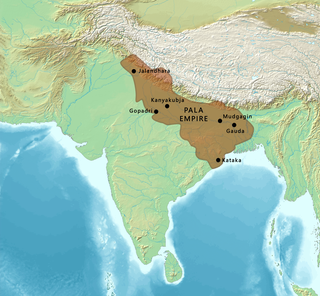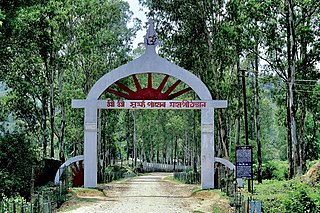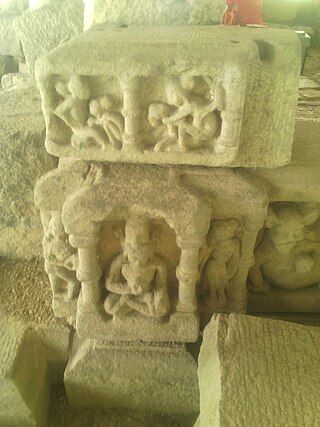
Harihara is the dual representation of the Hindu deities Vishnu (Hari) and Shiva (Hara). Harihara is also known as Shankaranarayana.

The Pāla Empire was an imperial power during the post-classical period in the Indian subcontinent, which originated in the region of Bengal. It is named after its ruling dynasty, whose rulers bore names ending with the suffix Pāla. The empire was founded with the election of Gopāla as the emperor of Gauda in late eighth century CE. The Pala stronghold was located in Bengal and eastern Bihar, which included the major cities of Gauḍa, Vikramapura, Pāṭaliputra, Monghyr, Somapura, Ramavati (Varendra), Tāmralipta and Jagaddala.

Gaṅgaikoṇḍa Chōḻapuram is a village located near to Jayankondam, Ariyalur district, Tamil Nadu, India. It became the capital of the Chola dynasty in c. 1025 by Chola emperor Rajendra I, and served as the capital for around 250 years.
North Bengal or Uttar Banga is a term used for the north-western part of Bangladesh and northern part of West Bengal. The Bangladesh part denotes the Rajshahi Division and Rangpur Division. Generally, it is the area lying west of Jamuna River and north of Padma River and includes the Barind Tract. The West Bengal part denotes Jalpaiguri Division and the Malda division together. The Bihar parts include the Kishanganj district. It also includes parts of Darjeeling Hills. Traditionally, the Ganga River divides Bengal into South Bengal and North Bengal, divided again into Terai and Dooars regions.

Jalpaiguri district is a district of the Indian state of West Bengal. The district was established in 1869 during British Raj. The headquarters of the district are in the city of Jalpaiguri, which is also the divisional headquarters of Jalpaiguri division.

Gorumara National Park is a national park in northern West Bengal, India. Located in the Dooars region of the Himalayan foothills, it is a medium-sized park with grasslands and forests. Gorumara National Park was established in 1992. It is primarily known for its population of Indian rhinoceros. The park was declared as the best among the protected areas in India by the Ministry of Environment and Forests for the year 2009.

Malbazar, also known as Mal, is a town and a municipality in Jalpaiguri district in the state of West Bengal, India. It is the headquarters of the Malbazar subdivision. It lies about 65 km from Jalpaiguri and 55 km from Siliguri. It lies on the bank of river Neora.
Binnaguri is a cantonment town located in the Jalpaiguri district of West Bengal state, India. It is located at 26° 46' N latitude and 89° 3' E longitude at an altitude of 216 metres above sea level.

Dhupguri is a town and a municipality of Jalpaiguri district near Jaldhaka River in the state of West Bengal, India. It is the headquarters of the Dhupguri subdivision.

Mainaguri is a Town and a Municipality in the Jalpaiguri Sadar subdivision of the Jalpaiguri district in the state of West Bengal, India. It is known as the "Gateway of the Dooars" and is a regionally significant tourist destination for Jalpesh Temple of Lord Shiva and nearby Gorumara National Park.

Jalpaiguri Sadar subdivision is an administrative division of the Jalpaiguri district in the Indian state of West Bengal.

Sri Surya Pahar is located about 12 km southeast of Goalpara, about 132 km northwest of Guwahati, is a significant but relatively unknown archaeological site in Assam, India. Goalpara is the nearest city from the site. The site is a hilly terrain where several rock-cut Shivalingas, votive stupas and the deities of Hindu, Buddhist and Jain pantheon are scattered in an area of about one km. The site is centered on the hills (Pahar) of Sri Surya which is profusely filled up with Shiva Lingas (Lingam). People have found 99999 Shiva Lingas were engraved here by Vyasa in order to build up a second Kashi and once it was one of the holiest pilgrimage sites in the region. There is no historical evidence exactly how many Lingams once dotted in these hills, but still there are hundreds of them, from tiny to large in size, scattered everywhere at the foot of the hill and covering the extensive area after centuries of neglect and pilferage. The exact figure of the Lingas in the hill is yet to be counted scientifically.

Maynaguri is a community development block that forms an administrative division in the Jalpaiguri Sadar subdivision of the Jalpaiguri district in the Indian state of West Bengal.

Dhupguri is a community development block that forms an administrative division in the Dhupguri subdivision of the Jalpaiguri district in the Indian state of West Bengal.

Uttaresvara Siva Temple is a 12th-century Hindu temple dedicated to Lord Siva located in Bhubaneswar, Odisha, India.

Madan Kamdev is an archaeological site in Baihata Chariali, Kamrup, Assam. The place dates back to the 9th and 10th century A.D. The excavation and ruins is dated back to the Pala dynasty of Kamarupa.

Kamarupa was a kingdom in Northeast India that was ruled by three dynasties from their capitals in Pragjyotishpura, Haruppeshwara, and Durjaya. The kingdom was known for its power and influence in the region.

The Shore Temple is a complex of temples and shrines that overlooks the shore of the Bay of Bengal. It is located in Mahabalipuram, about 60 kilometres (37 mi) south of Chennai in Tamil Nadu, India.

Baneswar Shiva temple is at Baneswar in the Cooch Behar II CD block in the Cooch Behar Sadar subdivision of the Cooch Behar district in West Bengal, India.

Jalpesh Temple is an important Hindu temple dedicated to the Bhramari Saktipitha's Bhairava as Jalpesh. The worshiped in this temple is Bhairava as Jalpesh, a form of Shiva – one of Hinduism's trinity of supreme divinity. The temple is located on the banks of the Jarda river, 7–8 km from Mainaguri town in the Indian state of West Bengal.


















